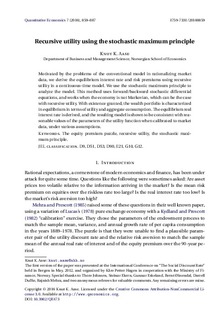| dc.contributor.author | Aase, Knut K. | |
| dc.date.accessioned | 2016-12-13T13:24:38Z | |
| dc.date.available | 2016-12-13T13:24:38Z | |
| dc.date.created | 2016-10-31T17:11:00Z | |
| dc.date.issued | 2016 | |
| dc.identifier.citation | Quantitative Economics. 2016, 7 (3), 859-887. | nb_NO |
| dc.identifier.issn | 1759-7323 | |
| dc.identifier.uri | http://hdl.handle.net/11250/2425049 | |
| dc.description.abstract | Motivated by the problems of the conventional model in rationalizing market data, we derive the equilibrium interest rate and risk premiums using recursive utility in a continuous-time model. We use the stochastic maximum principle to analyze the model. This method uses forward/backward stochastic differential equations, and works when the economy is notMarkovian, which can be the case with recursive utility.With existence granted, the wealth portfolio is characterized in equilibrium in terms of utility and aggregate consumption. The equilibrium real interest rate is derived, and the resulting model is shown to be consistentwith reasonable values of the parameters of the utility function when calibrated to market data, under various assumptions. | |
| dc.language.iso | eng | nb_NO |
| dc.title | Recursive utility using the stochastic maximum principle | nb_NO |
| dc.type | Journal article | nb_NO |
| dc.type | Peer reviewed | nb_NO |
| dc.source.pagenumber | 859-887 | nb_NO |
| dc.source.volume | 7 | nb_NO |
| dc.source.journal | Quantitative Economics | nb_NO |
| dc.source.issue | 3 | nb_NO |
| dc.identifier.doi | 10.3982/QE473 | |
| dc.identifier.cristin | 1395976 | |
| cristin.unitcode | 191,10,0,0 | |
| cristin.unitname | Institutt for foretaksøkonomi | |
| cristin.ispublished | true | |
| cristin.fulltext | original | |
| cristin.qualitycode | 2 | |
